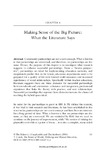Making Sense of the Big Picture: What the Literature Says
| dc.contributor.author | Lynch, TJ | en |
| dc.date.accessioned | 2016-10-09T15:02:28Z | |
| dc.date.accessioned | 2016-10-09T15:29:39Z | |
| dc.date.available | 2016-10-09T15:02:28Z | |
| dc.date.available | 2016-10-09T15:29:39Z | |
| dc.date.issued | 2016-07-30 | en |
| dc.identifier.isbn | 3319316664 | en |
| dc.identifier.isbn | 978-3-319-31667-3 | en |
| dc.identifier.other | 4 | en |
| dc.identifier.uri | http://hdl.handle.net/10026.1/6378 | |
| dc.description | This book uses the example of a partnership journey between universities, schools, the local health industry as well as a number of government organisations which worked to ensure the growth of physical education in primary education. The initiative employed the United Nations (UN) ideals as a model and contextualised them within local schools and communities. What began as a pathway seed quickly grew to involve multi-stakeholder partnerships and therefore explores how the UN Sustainable Development Goals (SDG) may be implemented at a grass roots level. | en |
| dc.description.abstract |
Community partnerships are not a new concept. What is known is that partnerships are contextual, and therefore, no partnerships are the same. Hence, the purpose of this chapter is to investigate what research suggests to enhance successful partnerships. From a ‘futures perspective’, partnerships are ideal for implementing education curricula, and megatrends predict that in the future, education departments need to be prepared for a quality of life with limited world resources and increased significance of social relationships. Specifically within teacher education, literature suggests there are three elements for successful partnerships between schools and universities: coherence and integration, professional experience that links the theory with practice, and new relationships. Successful partnerships that espouse these elements increase the chance of reaching the hybrid space ideal. | en |
| dc.format.extent | 11 | en |
| dc.format.extent | 53 - 66 (14) | en |
| dc.format.medium | e-book & hard cover | en |
| dc.language.iso | en | en |
| dc.publisher | Springer International Publishing | en |
| dc.relation.ispartof | The Future of Health, Wellbeing and Physical Education Optimising Children's Health through Local and Global Community Partnerships | en |
| dc.relation.replaces | http://hdl.handle.net/10026.1/6357 | |
| dc.relation.replaces | 10026.1/6357 | |
| dc.subject | Physical Education | en |
| dc.subject | Health | en |
| dc.subject | Well-being | en |
| dc.subject | Partnerships | en |
| dc.subject | Community | en |
| dc.subject | Collaborations | en |
| dc.subject | Teacher Education | en |
| dc.subject | Social Justice | en |
| dc.subject | Leadership | en |
| dc.subject | Problem Solving | en |
| dc.subject | Sustainable Development Goals | en |
| dc.subject | United Nations | en |
| dc.title | Making Sense of the Big Picture: What the Literature Says | en |
| dc.type | Book Chapter | |
| plymouth.author-url | http://www.timothylyncheducation.com/ | en |
| plymouth.edition | 1 | en |
| plymouth.volume | 1 | en |
| plymouth.publisher-url | http://link.springer.com/chapter/10.1007/978-3-319-31667-3_4 | en |
| plymouth.publication-status | Published | en |
| plymouth.series | 2016 | en |
| dc.identifier.doi | 10.1007/978-3-319-31667-3_4 | en |
| plymouth.organisational-group | /Plymouth | |
| plymouth.organisational-group | /Plymouth/Faculty of Arts, Humanities and Business | |
| plymouth.organisational-group | /Plymouth/Faculty of Arts, Humanities and Business/Plymouth Institute of Education | |
| dc.publisher.place | Switzerland | en |
| dc.rights.embargoperiod | No embargo | en |
| rioxxterms.versionofrecord | 10.1007/978-3-319-31667-3_4 | en |
| rioxxterms.licenseref.uri | http://www.rioxx.net/licenses/all-rights-reserved | en |
| rioxxterms.type | Book chapter | en |
| plymouth.oa-location | http://www.palgrave.com/de/book/9783319316666 | en |


